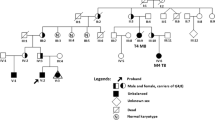Summary
Association patterns of acrocentric chromosomes in 6400 metaphases from a sample population of 64 parents of normal children and 64 parents of mongol children have been studied. The individual pairs of acrocentric chromosomes were identified by coloration with Quinacrine Mustard and by heat-controlled denaturation. The data are concerned with the frequency of association, frequency of different association types by the number of associating chromosomes, and frequency of different associations by the type of associating chromosomes.
The parents of mongol children have more satellite association (s.a) and more complex associations. There is a statistically significant difference in the distribution of the s.a. by the types of associating chromosomes. In the parents of mongol children the chromosome 15 is less associated, all the s.a. with the chromosome 22 are increased except the 22/15 and, in the case of the chromosome 21, only the s.a. 21/22 is more frequent. S.a. between homologous chromosomes is significantly less frequent that the s.a. between heterologous chromosomes. This distribution is significantly different in the parents of mongoloid children in which there are more s.a. between homologous chromosomes only by the increase of s.a. 22/22. Lastly, in the parents of mongoloid children, chromosomes 21, 22, and 14 are significantly more often associated.
Résumé
Cette étude, portant sur 6.400 métaphases intéressant 128 personnes, a montré que les parents de trisomiques 21 ont davantage d'associations entre acrocentriques, davantage d'associations multiples et un plus grand nombre de chromosomes intéressés dans les associations. Ces caractères ne varient ni avec le sexe, ni avec l'âge. Il existe d'autre part une différence très significative dans la distribution des différents types d'associations. Chez les parents de trisomiques 21, toutes les associations avec le chromosome 15 sont diminuées, toutes les associations avec le chromosome 22 sont augmentées, sauf l'association 22/15, et, enfin, concernant le chromosome 21, seule l'association 21/22 est augmentée. Nous avons encore constaté que les associations entre homologues étaient significativement plus rares que les associations entre hétérologues. Cette distribution est significativement différente chez les parents de trisomiques 21 où il y a davantage d'associations entre homologues et ceci par la seuleaugmentation des associations 22/22. Enfin, chez les parents de trisomiques, les chromosomes 21, 22 et 14 sont significativement plus souvent associés. Les autres aspects concernant les associations avec l'Y ou d'autres régions chromosomiques ont été répertoriés.
Similar content being viewed by others
Bibliographie
Carpentier, S., Dutrillaux, B., Lejeune, J.: Effet du milieu ionique sur la dénaturation thermique ménagée des chromosomes humains. Ann. Génét. 15, 203 (1972)
Caspersson, T., Zech, L., Johansson, C.: Analysis of human metaphase chromosome set by aid of DNA-binding fluorescent agents. Exp. Cell Res. 62, 490 (1970)
Cooke, P.: Non-random participation of chromosomes 13–14 et 15 in acrocentric associations. Humangenetik 13, 309 (1971)
Curtis, D. J.: Acrocentric associations in mongol populations. Humangenetik 22, 17 (1974)
Dutrillaux, B., Couturier, J.: Techniques d'analyses chromosomiques. Monographie annuelle de la Soc. Fr. Biol. Clin. Paris: Expansion Scientifique Française éd. 1972
Dutrillaux, B., Lejeune, J.: Sur une nouvelle technique d'analyse du caryotype humain. C.R. Acad. Sci. (Paris) 272, 2638 (1971)
Edwards, J. H.: Chromosomal association in man. Lancet 1961 II, 317
Mattei, J.-F.: Etude génétique des parents d'enfants trisomiques 21. Thèse, Marseille 1974
Ohno, S., Trujillo, J. M., Kaplan, W. D., Kinosita, R.: Nucleolus organizers in the causation of chromosomal anomalies in man. Lancet 1961 II, 123
Patil, S. R., Lubs, H. A.: Non-random association of human acrocentric chromosomes. Humangenetik 13, 157 (1971)
Polani, P. E., Briggs, J. H., Ford, C. E., Clark, C. M., Berg, J. M.: A mongol girl with 46 chromosomes. Lancet 1960 I, 721
Stahl, A., Luciani, J. M.: Nucleoli and chromosomes: their relationship during the meiotic prophase of the human fetal ovocyte. Humangenetik 14, 269 (1972)
Turpin, R., Lejeune, J.: Les chromosomes humains, vol. 1, p. 535. Paris: Gauthier-Villars 1965
Zang, K. D., Back, E.: Quantitative studies on the arrangement of human metaphase chromosomes. I. Individual features in the association pattern of the acrocentric chromosomes of normal males and females. Cytogenetics 7, 455 (1968)
Author information
Authors and Affiliations
Rights and permissions
About this article
Cite this article
Mattei, J.F., Mattei, M.G., Ayme, S. et al. Etude chromosomique chez les parents d'enfants trisomiques 21. Associations entre chromosomes acrocentriques. Hum Genet 25, 29–48 (1974). https://doi.org/10.1007/BF00281004
Received:
Issue Date:
DOI: https://doi.org/10.1007/BF00281004




